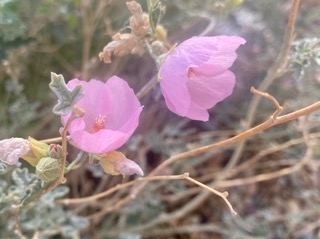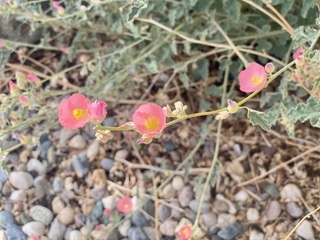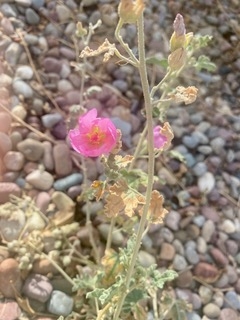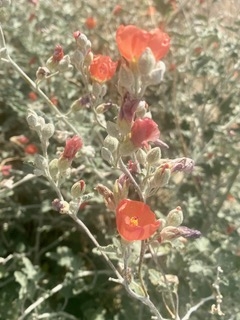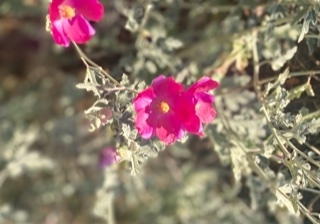Desert globemallow or apricot mallow (Sphaeralcea ambigua) is a local favorite, brightening the roadsides and hillsides of the Eastern Sierra region dependably every year. People love the delicate globes, and thanks to our local Bristlecone Chapter of the California Native Plant Society and their annual native plant sale, hundreds of people now get to enjoy the show in their own yards.
The common names pretty much say it all—they do well with little water, and they are covered in spring with 1-inch, 5-petaled, bowl-shaped apricot blossoms. But let's dig a little deeper, into the scientific name. The Greek words σφα?ρα (sphaira) and αλκεα (alkea) translate to “sphere” and “mallow.” Sphere obviously describes the shape of the flowers, and mallow tells us that this plant is in the family Malvaceae—the same family that includes cotton, okra and hollyhock. If you check the leaves of each of these plants, you'll immediately notice one of the family characteristics—palmately lobed leaves (like fingers on a hand).
It's not the genus, but the specific epithet* that I want to focus on here—ambigua—the color of this species is ambiguous. Calflora lists eight other species of Sphaeralcea in California, nearly all of them orange nearly all the time. Sphaeralcea ambigua is apparently the exception. This species comes in three different botanical varieties: ambigua (our local variety), rugosa and rosaceae. It is especially among the rosaceae populations that colors can vary. I learned of this some years back, when I bought a plant in Tucson. In that area, this species comes in a range of pastels, from white to mauve, peach, pink, lavender, and occasionally deep wine reds.
That original plant has given me three new plants, two pinkish and one apricot. As a bonus, that plant and its descendants seem to have a more vigorous revival in the fall than the plants I have purchased locally. Because Tucson gets a summer monsoon season, many plants bloom in both the spring and the fall, so I'm assuming my plants share that characteristic more than the plants from summer-dry California.
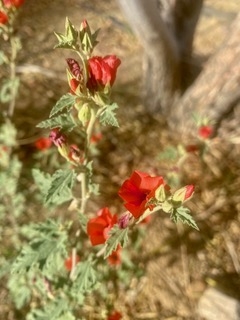
Helpful links
‘Childerly' is a hybrid developed in England
You can see some other colors here
A search of “mallow” at High Country Gardens gives you some closely related plants that will also do well in our area
Seeds from the Tucson area may be more likely to give you shades other than apricot
*By the way, Wikipedia has lists of the most common plant species epithets (A-H and I-Z)!
